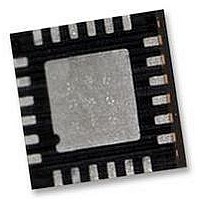IMU-3000 INVENSENSE, IMU-3000 Datasheet - Page 18

IMU-3000
Manufacturer Part Number
IMU-3000
Description
GYRO, TRI-AXIS, PROG +/-2000 DEG/S
Manufacturer
INVENSENSE
Datasheet
1.IMU-3000.pdf
(56 pages)
Specifications of IMU-3000
No. Of Axes
3
Sensor Case Style
QFN
No. Of Pins
24
Supply Voltage Range
2.1V To 3.6V
Operating Temperature Range
-40°C To +85°C
Interface
I2C, Serial
Interface Type
I2C, Serial
Rohs Compliant
Yes
Lead Free Status / RoHS Status
Lead free / RoHS Compliant
chip gyroscopes and an external accelerometer. The resulting data can be read from IMU-3000’s FIFO. The
DMP has access to certain of the IMU’s external pins, which can be used for synchronizing external devices
to the motion sensors, or generating interrupts for the application.
The purpose of the DMP is to offload both timing requirements and processing power from the host
processor. Typically, motion processing algorithms should be run at a high rate, often around 200Hz, in order
to provide accurate results with low latency. This is required even if the application updates at a much lower
rate; for example, a low power user interface may update as slowly as 5Hz, but the motion processing should
still run at 200Hz. The DMP can be used as a tool in order to minimize power, simplify timing and software
architecture, and save valuable MIPS on the host processor for use in the application.
5.5
The IMU-3000 communicates to a system processor using the I
a slave when communicating to the system processor. The logic level for communications to the master is
set by the voltage on the VLOGIC pin. The LSB of the of the I
5.6
The IMU-3000 has a secondary I
This bus has two operating modes: I
accelerometer connected to the secondary I
connects the primary and secondary I
communicate with the external accelerometer.
Secondary I
Secondary I
The logic levels of the secondary I
and 8).
•
•
Primary I
Secondary I
I
accelerometer. In this mode, the IMU-3000 directly obtains sensor data from an accelerometer thus
allowing the on-chip DMP to generate sensor fusion data without intervention from the system
applications processor. In I
returning the following data from the accelerometer:
Pass-Through Mode: allows an external system processor to act as master and directly
communicate to the external accelerometer connected to the secondary I
AUX_CL). This is useful for configuring the accelerometer, or for keeping the IMU-3000 in a low-
power mode, when only the accelerometer is to be used. In this mode, the secondary I
control logic (third-party accelerometer Interface block) of the IMU-3000 is disabled, and the
secondary I
and 24) through analog switches.
2
C Master Mode: allows the IMU-3000 to directly access the data registers of an external digital
2
2
C Bus Modes of Operation:
C Bus I/O Logic Levels
2
C Serial Communications Interface
2
2
C pins AUX_DA and AUX_CL (Pins 6 and 7) are connected to the main I
C Serial Interface for Third-Party Accelerometer
X accelerometer data (2 bytes)
Y accelerometer data (2 bytes)
Z accelerometer data (2 bytes)
IMU-3000 Product Specification
2
C bus for communicating to an off-chip 3-axis digital output accelerometer.
2
C bus can be programmed to be either VDD or VLOGIC (see Sections 7
2
C master mode, the IMU-3000 can be configured to perform burst reads,
2
C Master Mode, where the IMU-3000 acts as a master to an external
2
C buses together, to allow the system processor to directly
2
C bus; and Pass-Through Mode, where the IMU-3000 directly
18 of 56
2
C slave address is set by pin 9 (AD0).
2
C serial interface; the device always acts as
Document Number: PS-IMU-3000A-00-01.1
Revision: 1.1
Release Date: 08/19/2010
2
C bus pins (AUX_DA and
2
C bus (Pins 23
2
C bus












